Innovation and Other Disciplines
Feb 26, 2024
By Ari Manor , CEO at ZOOZ
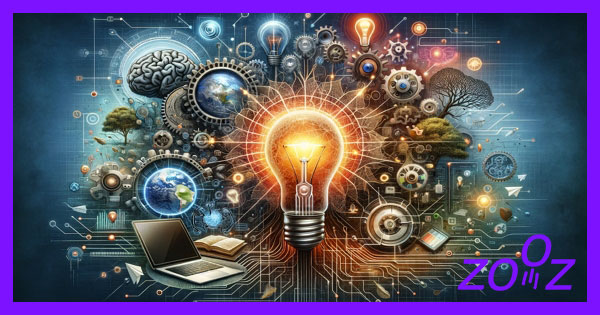
This is one in a series of articles that provide detailed and updated information about Innovation.In this specific article, which focuses on Innovation and Other Disciplines, you can read about:
- Are Innovation and Creativity the Same
- Where Innovation and Creativity Meet
- How Innovation Differs from Creativity
- Innovation Versus Creativity
- Innovation without Creativity
- Are Innovation and Invention the Same Thing
- Innovation VS Invention
- Is Innovation the Same as Idea?
- Innovation without Execution is Hallucination
- Innovation and Design
- Innovation and Technology
- Innovation VS Improvement
- Innovation VS Renovation
- Innovation VS Entrepreneurship
- Innovation and Strategy
- Innovation with AI
For additional articles about Innovation, see the Topic Menu.
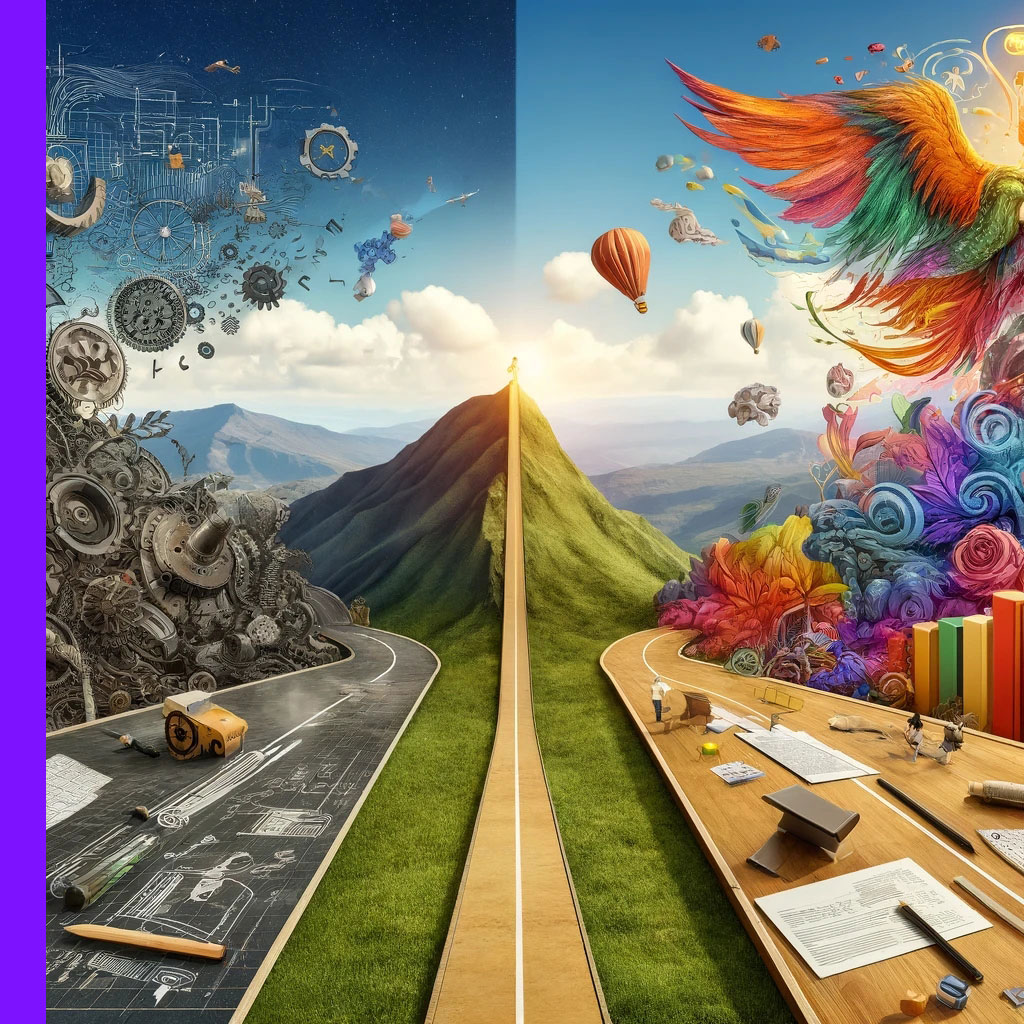
Are Innovation and Creativity the Same
Innovation and creativity are closely linked and sometimes used interchangeably, but nevertheless they are not the same:
- Creativity is about unleashing the potential of the mind to conceive new ideas. It’s characterized by the ability to perceive the world in new ways, find hidden patterns, make connections between seemingly unrelated phenomena, and generate solutions. Creativity involves thinking, then producing.
- Innovation, on the other hand, is the implementation of something new: a new idea, method, or device. It's the process of translating an idea or invention into a good or service that creates value for which customers will pay. To be called an innovation, an idea must be replicable at an economical cost and must satisfy a specific need. Innovation involves producing, then thinking.
Here's a simple list that distinguishes the two:
Creativity
- Ideation without the necessity of immediate application.
- Often subjective, can be art for art’s sake.
- About divergent thinking – generating many unique ideas.
Innovation
- The practical implementation of creative ideas.
- Objective in nature, with a focus on real-world application.
- Convergent thinking – narrowing down ideas to the best one.
For businesses, understanding the difference is crucial. Creativity is needed to fuel the fires of innovation, but without the structured approach of innovation, creative ideas might remain mere fantasies. Companies that cultivate both creativity and innovation are often the ones that revolutionize industries and push society forward.
So, are innovation and creativity the same? Certainly not. Creativity is the soil where the seeds of innovation are planted. But without the process of innovation, creative ideas may not see the light of day in the marketplace. Understanding this distinction can be the first step toward harnessing both effectively to drive growth and success in any endeavor.

Where Innovation and Creativity Meet
Innovation and creativity intersect in the dynamic space where novel ideas are transformed into tangible improvements or creations that have real-world application and value. This convergence is the sweet spot for businesses and individuals looking to disrupt markets or establish new standards.
Innovation and Creativity Intersection
Here is how the intersection between Innovation and Creativity is navigated and why it’s essential for groundbreaking success:
- Fostering an Innovative Culture: Organizations that recognize the importance of creativity often establish environments where innovative thinking thrives. These are spaces where brainstorming is encouraged, and failure is seen as a step towards success.
- The Ideation Process: Creativity is the powerhouse of idea generation, and innovation is the framework that turns these ideas into reality. Whether it’s a new app, a business model, or a service, the ideation process is where innovation meets creativity.
- Design Thinking: This approach depends on creative problem-solving strategies that empathize with users and lead to innovative solutions. It involves five phases—empathize, define, ideate, prototype, and test—each requiring a balance of creative and innovative thinking.
- R&D Initiatives: Research and development (R&D) is the practical embodiment of this meeting point. R&D teams explore creative solutions to complex problems and then innovate to make these solutions viable.
- Cross-disciplinary Collaboration: When different fields come together—be it technology and design, or engineering and art—the fusion of diverse creative thoughts leads to innovations that might not occur within a single discipline.
Creativity and Innovation Meeting Point
In essence, creativity and innovation meet at the point of action. It's where a creative concept is pushed forward through the innovation process to become something that affects change and adds value. This meeting point is crucial for any organization because:
- It leads to the development of competitive advantages.
- It drives growth and adaptation in an ever-changing market.
- It encourages a forward-thinking mindset that is essential for long-term survival.
How to maintain a good flow between creativity to Innovation?
Maintaining a good flow between creativity and innovation in businesses involves fostering an environment where ideas can flourish and be effectively executed. Here are a few strategies to achieve this balance:
- Encourage Open Communication: Create an open environment where team members feel comfortable sharing their ideas and feedback. This can spark creativity and lead to innovative solutions.
- Foster Diversity and Inclusion: Diverse teams bring a wide range of perspectives, which can enhance creativity and drive innovation. Encourage collaboration between departments and individuals with different backgrounds.
- Implement Idea Management Systems: Use platforms or tools that allow employees to submit, share, and discuss ideas. This helps in tracking the progress of these ideas from inception to implementation.
- Provide Time and Resources for Experimentation: Allocate time and resources for employees to experiment with new ideas. This could be through hackathons, innovation labs, or dedicated "innovation time."
- Celebrate Failures and Successes: Recognize both successful innovations and constructive failures. This encourages a culture of risk-taking and continuous learning.
- Continuous Learning and Development: Offer opportunities for employees to learn new skills and stay updated on industry trends. This can inspire new ideas and improve the company's ability to innovate.
- Strategic Alignment: Ensure that creativity and innovation efforts are aligned with the business's strategic goals. This helps in prioritizing ideas that offer the most value.
- Leadership Support and Involvement: Leadership should actively support and participate in the innovation process. Their involvement can provide direction and resources needed to bring creative ideas to life.
Where innovation and creativity meet, there is potential for the extraordinary. It’s at this crossroads that the future is shaped and where visionaries and pragmatists alike find their common ground. Ensuring a seamless flow between creativity and innovation hinges on fostering an environment where these two forces meet and flourish, turning groundbreaking ideas into real-world value. At this critical junction, businesses can truly disrupt markets and set new standards by championing open communication, diversity, and the resources necessary for innovation to thrive.
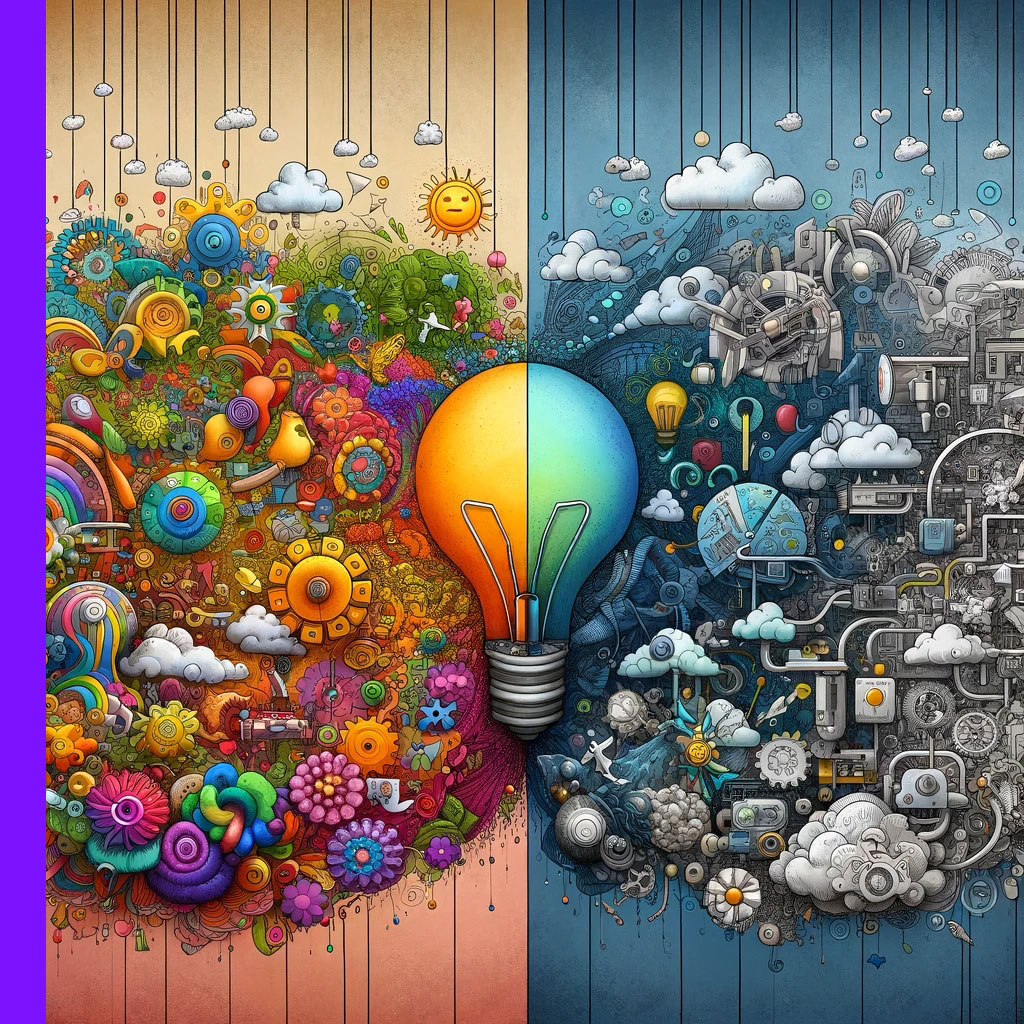
How Innovation Differs from Creativity
While creativity and innovation often walk hand in hand, understanding how they differ is crucial for anyone looking to harness their power in the business world or any other field. Here are the key distinctions:
Definition and Scope
- Creativity is inherently about generating new and original ideas. It's an abstract process that involves dreaming up new concepts, initially without the constraints of practicality or applicability.
- Innovation is the application of those creative ideas in a practical way. It’s about implementation and bringing something new to the market or society — a product, a solution, a method, or even a new way of thinking.
Process Orientation
- Creativity is often non-linear and chaotic. It doesn’t follow a predictable pattern and it may thrive in open, unrestricted environments. However, it can be accelerated using thinking tools (constrains increase creativity).
- Innovation is more structured. It involves specific stages such as ideation, validation, prototyping, and commercialization. It’s a path with clear milestones and objectives.
Outcome
- Creative endeavors don't necessarily result in tangible outcomes. The arts, for example, are a product of creativity that may not have a direct functional purpose other than to evoke emotion or provoke thought.
- Innovations lead to definable change. They result in something that can be implemented and often measured — a new device, an improved service, or an enhanced process.
Risk and Failure
- Creativity involves taking risks and embracing failure as a part of the journey. It's about pushing boundaries and exploring the unknown.
- Innovation also involves risk, but it's a calculated one. Innovations are typically pursued in the context of solving a specific problem or addressing a particular need, often with a business case or clear goal in mind.
Value Creation
- Creativity in itself does not necessarily create value. A creative idea might be brilliant, but if it’s not applicable or needed, it might not hold value in a business or practical sense.
- Innovation is driven by the goal of creating value. It turns creative ideas into something useful and desirable, which people are willing to pay for.
In summary, creativity is about unleashing potential and exploring possibilities without the constraints of the real world, while innovation is about grounding these possibilities within the realm of what is feasible and valuable. Businesses that foster both are often the ones that lead their industries, as they can dream big and then make those dreams a reality.
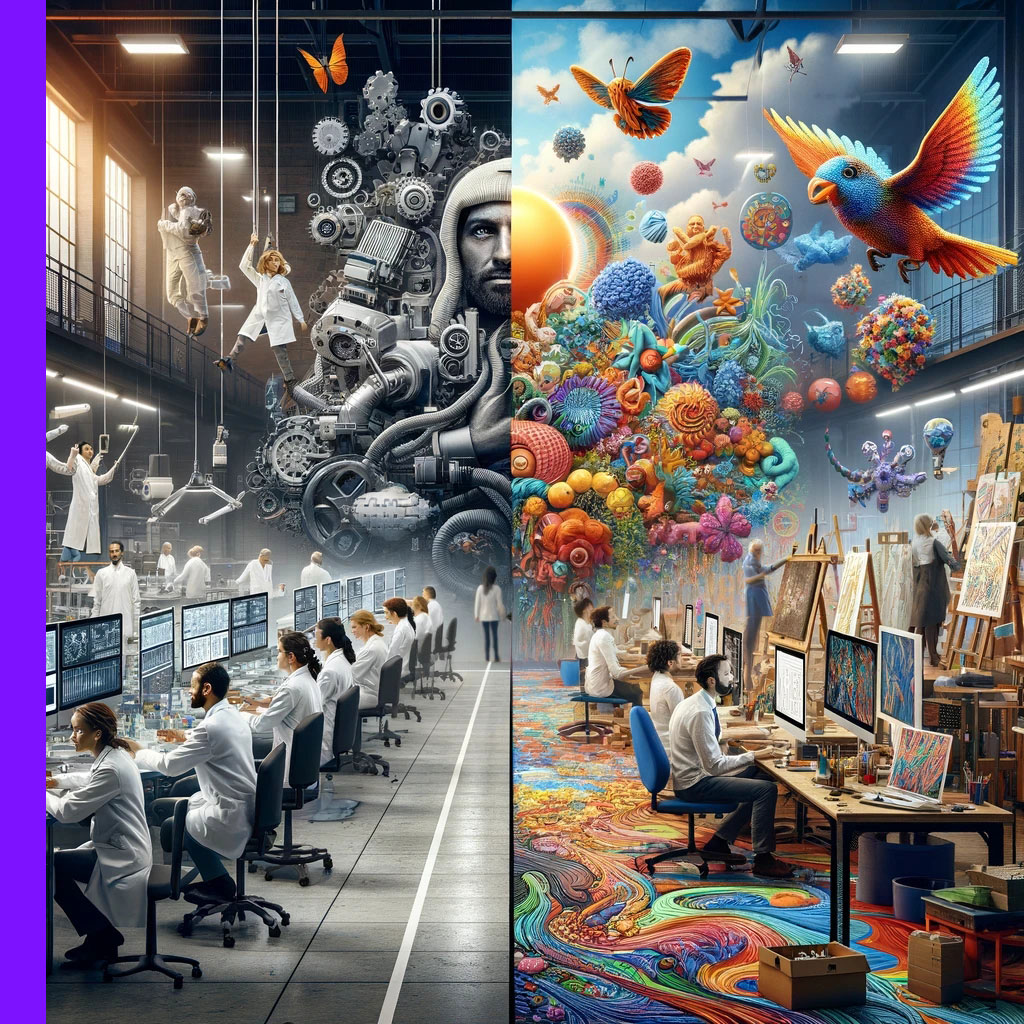
Innovation Versus Creativity
The debate on innovation versus creativity is a longstanding one, with each playing a critical role in successful outcomes in business and other fields. Following, we delve into their relationship and differences.
Origin and Dependence
- Creativity is the origin of new ideas. It’s the mental capacity to conceive something original or unusual. It relies on innovation processes to take shape and manifest in reality.
- Innovation is the application and successful exploitation of new ideas. It depends on creativity but extends beyond it to include the delivery of real-world value.
Nature of Output
- Creative outputs are often intangible, such as ideas, concepts, artistic expressions, or theories.
- Innovations result in tangible outcomes like new products, services, or improved processes that have a practical impact.
Measurement
- Creativity is inherently subjective, making it challenging to quantify. What may appear as a novel and creative idea to one individual might not seem so to another. Consequently, it is common to engage panels of subject matter experts to assess the creativity level of specific ideas, often employing a subjective scale, such as 1 to 7, to harness “expert-crowd” wisdom in measuring creativity.
- Innovation can be measured in terms of market success, efficiency gains, increased revenue, or other quantifiable metrics. Businesses frequently assess innovation through metrics like the percentage of revenue from new products or the number of new products introduced each quarter.
Utility
- Creativity does not always have immediate utility or application. A creative idea might be appreciated for its novelty alone.
- Innovation inherently aims at utility. It’s not just about creating something new; it’s about creating something new that solves a problem or fulfills a need.
Risk Factor
- Creativity involves the risk of the unknown. It requires venturing into unexplored territory without any guarantee of success or acceptance.
- Innovation involves calculated risks. Although innovative projects can fail, they are typically pursued after some level of validation or proof of concept.
Cultural Influence
- Creativity can be influenced by cultural, social, and personal factors. It can be seen as an expression of individual or collective consciousness.
- Innovation often emerges from a culture that not only values creativity but also supports risk-taking, experimentation, and the practical realization of ideas.
In essence, while creativity is necessary for innovation, it is not sufficient on its own. Creativity is about coming up with the big idea; innovation is about executing the idea, making it a reality. They are two sides of the same coin; without creativity, there can be no innovation, and without innovation, creative ideas remain dormant and unrealized. Understanding their interplay is essential for anyone looking to drive progress, whether in business, technology, or the arts.
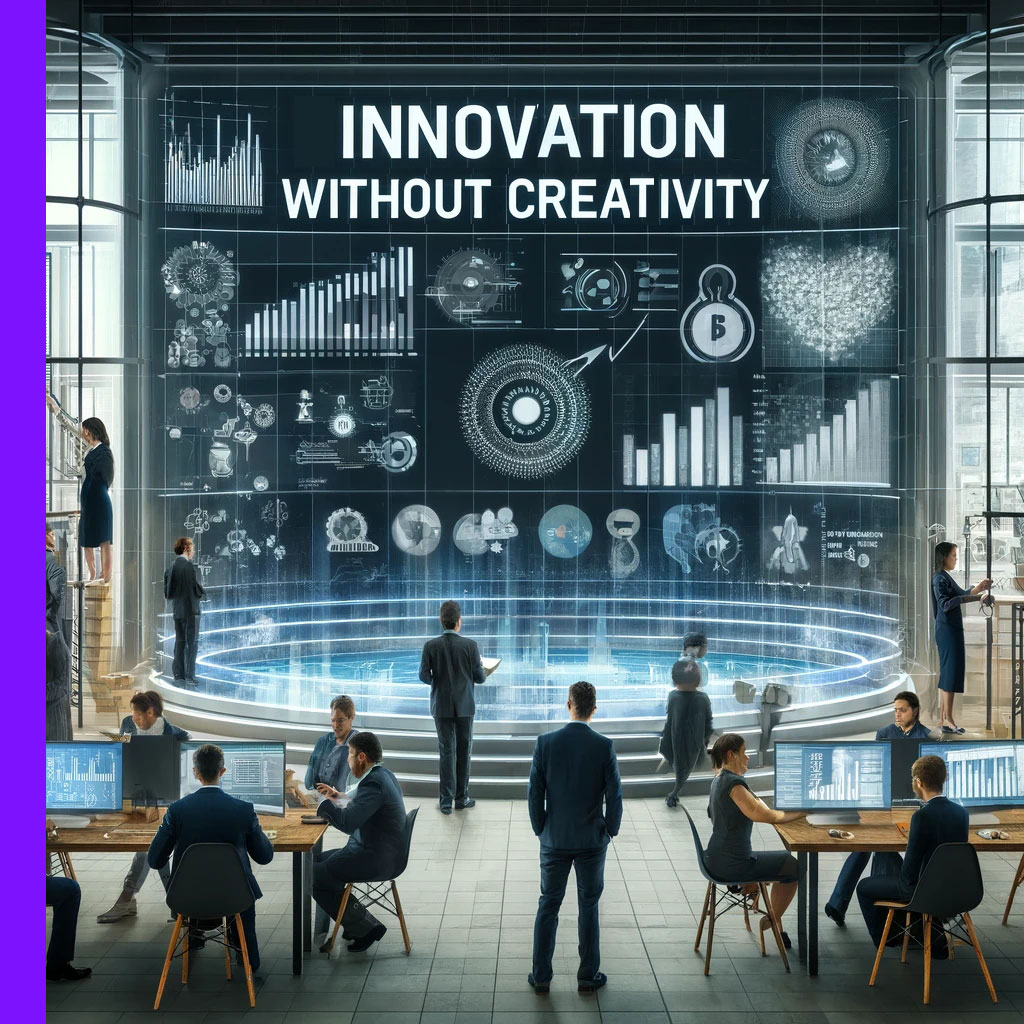
Innovation without Creativity
The notion of innovation without creativity may seem counterintuitive; after all, how can something be novel or improved without a creative spark? However, innovation does not always require creativity in its purest form. Let’s explore how innovation can manifest without traditional creativity:
- Incremental Improvements: Innovation often occurs as incremental changes to existing products or processes. These are not necessarily born from a creative idea but from systematic analysis and improvement over time.
- Toyota's philosophy of Kaizen, which focuses on continuous, incremental improvements in manufacturing processes, exemplifies innovation without the need for groundbreaking creativity, leading to significant enhancements in efficiency and quality over time.
- Toyota's philosophy of Kaizen, which focuses on continuous, incremental improvements in manufacturing processes, exemplifies innovation without the need for groundbreaking creativity, leading to significant enhancements in efficiency and quality over time.
- User Feedback and Data-Driven Decisions: Many innovations come from listening to user feedback or analyzing data trends rather than creative brainstorming. For instance, a feature added to a software product based on user request is an innovation derived from a practical need, not necessarily a creative process.
- Spotify’s use of data analytics to refine its music recommendation algorithms is a prime example of innovation driven by user feedback and data trends, optimizing user experience without traditional creative ideation.
- Spotify’s use of data analytics to refine its music recommendation algorithms is a prime example of innovation driven by user feedback and data trends, optimizing user experience without traditional creative ideation.
- Combining Existing Concepts: Sometimes, innovation results from the combination of existing ideas or technologies. The creativity involved is minimal since it relies on pre-existing elements being brought together in new ways, often driven by practical problem-solving rather than creative thought.
- The creation of the smartphone was an innovation that combined existing technologies—telephone, internet, camera—into a single device, transforming communication without originating from a singularly creative idea.
- The creation of the smartphone was an innovation that combined existing technologies—telephone, internet, camera—into a single device, transforming communication without originating from a singularly creative idea.
- Technology-Enabled Innovations: With the advent of AI and machine learning, many innovations are now data-driven. For example, algorithms can identify patterns leading to new marketing strategies or financial models without human creative input.
- Netflix's recommendation system, powered by machine learning, exemplifies innovation where algorithms analyze viewing patterns to suggest personalized content, showcasing how technology can drive innovation independently of human creativity.
- Netflix's recommendation system, powered by machine learning, exemplifies innovation where algorithms analyze viewing patterns to suggest personalized content, showcasing how technology can drive innovation independently of human creativity.
- Regulatory Changes: At times, changes in regulations or compliance standards necessitate innovation. Companies may have to alter their processes or products to comply with new laws. While this requires ingenuity, it is not necessarily rooted in creativity but in necessity.
- The financial industry's development of secure, blockchain-based transactions in response to increasing demands for transparency and security demonstrates innovation driven by the need to comply with regulatory standards, rather than creativity.
- The financial industry's development of secure, blockchain-based transactions in response to increasing demands for transparency and security demonstrates innovation driven by the need to comply with regulatory standards, rather than creativity.
- Adaptation to Market Changes: Businesses often have to innovate to survive due to changes in market conditions or consumer behaviors. This type of innovation is reactive and adaptive, rather than being driven by original creative ideas.
- The pivot of many restaurants to offering contactless delivery and pickup services during the COVID-19 pandemic illustrates innovation born out of necessity to adapt to changing market conditions, rather than from a creative breakthrough.
- The pivot of many restaurants to offering contactless delivery and pickup services during the COVID-19 pandemic illustrates innovation born out of necessity to adapt to changing market conditions, rather than from a creative breakthrough.
- Inventive Thinking Tools: Originally designed for engineers addressing complex technological challenges, Systematic Inventive Thinking (SIT) offers a structured, step-by-step approach to uncovering feasible and unexpectedly original solutions. When applied to product development and creative advertising, these tools maintain a methodical and systematic nature, eliminating the need for spontaneous creativity. While individual steps may not appear creative in isolation, the final outcomes—be it solutions, inventions, or advertisements—are remarkably and surprisingly innovative.
- At Kapro, a precision , a precision tools company, participants in our Systematic Innovation™ workshops utilized SIT tools to systematically develop idea banks with hundreds of innovative ideas for new rulers, rafter squares, metric tape measures, levels, and laser levels. The process did not rely on waiting for serendipitous moments, as SIT provides a framework and six inventive thinking tools for generating ideas in a structured, step-by-step manner. Further details can be found here, along with some successful innovations we developed, which are presented here.
- At Kapro, a precision , a precision tools company, participants in our Systematic Innovation™ workshops utilized SIT tools to systematically develop idea banks with hundreds of innovative ideas for new rulers, rafter squares, metric tape measures, levels, and laser levels. The process did not rely on waiting for serendipitous moments, as SIT provides a framework and six inventive thinking tools for generating ideas in a structured, step-by-step manner. Further details can be found here, along with some successful innovations we developed, which are presented here.
In summary, while creativity is a source of innovation, it is not the only one. Innovation can also arise from necessity, customer insight, market trends, the strategic combination of existing ideas, and structured thinking tools. These innovations may lack the flamboyance of creativity-driven breakthroughs, but they are no less significant in their impact on business success and progress. Understanding this broader scope of innovation can help organizations systematically innovate time and again, without waiting for serendipitous moments.
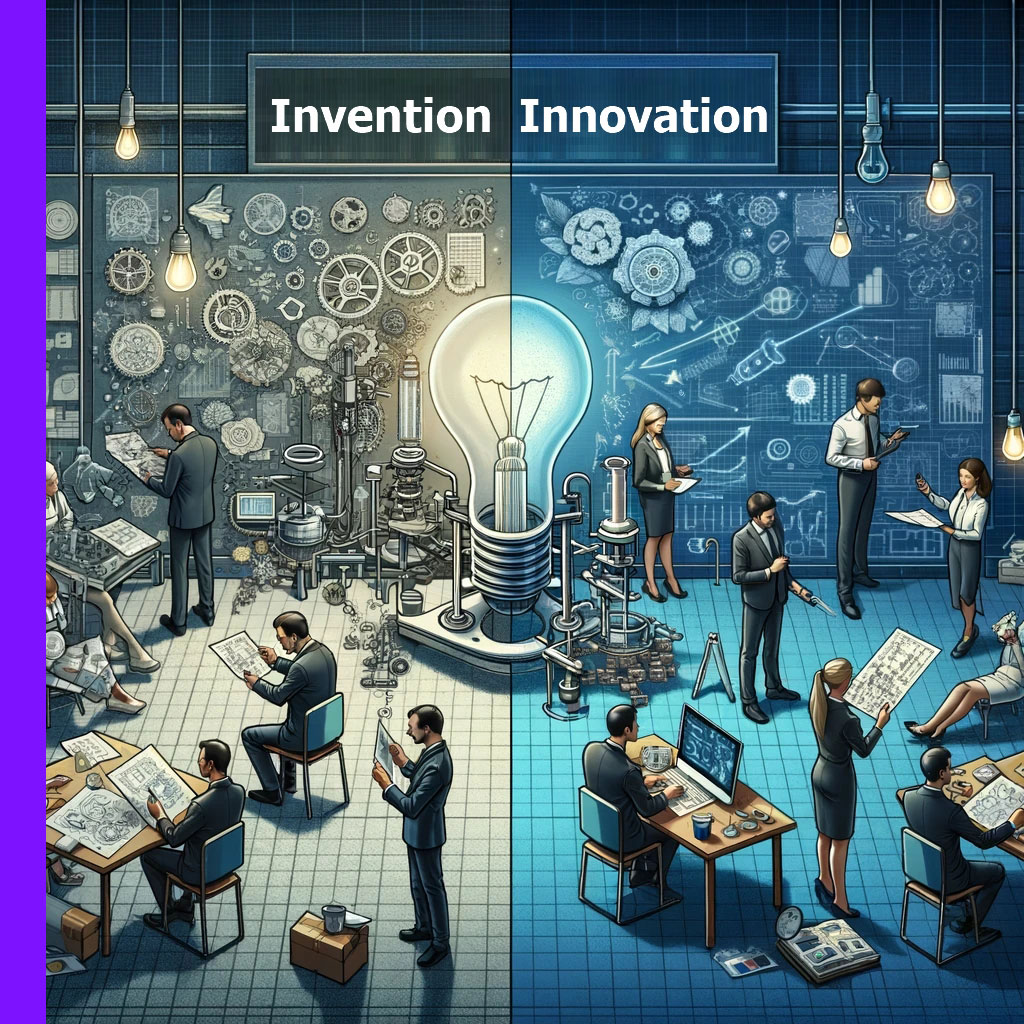
Are Innovation and Invention the Same Thing
Innovation and invention are not the same, although they're often conflated. Their differences are pivotal in understanding the lifecycle of a product or concept from creation to market success.
- Invention Defined: An invention is a novel creation that did not exist before. It's the first occurrence of an idea for a product or process. Inventions are often protected by patents and are the result of ingenuity and technical skills.
- Innovation Explained: Innovation takes an invention or an existing idea and improves upon it, or adapts it in a way that is new. Innovation makes the idea applicable, profitable, and accessible to a broader audience.
- Invention as a Starting Point: Inventions are the seeds from which innovations grow. Without the invention of the electric light bulb by Thomas Edison, for instance, we wouldn’t have the innovation of energy-efficient LED lighting.
- Innovation Drives Adoption: Innovations are what drive an invention forward into the marketplace. They are often what turn a technical prototype into a mass-produced item available to consumers.
- Examples in Technology: The invention of the microprocessor was a revolutionary event. The innovation was using it to create personal computers, smartphones, and countless other devices that shape our daily lives.
- Market Success: Inventions do not guarantee market success; many inventions never progress beyond the patent or prototype stage. Innovations, however, are geared towards market success and often involve business models, marketing, and strategic planning.
- Timing and Impact: An invention can occur and remain dormant for years before it is innovated into something useful. The timing of an innovation in relation to consumer readiness can significantly impact its success.
In summary, while an invention is the creation of something new, innovation is the process of bringing an invention to market and making it a success. Invention can exist without innovation, but without innovation, an invention might never reach its full potential. It is innovation that transforms the ingenuity of an invention into a product or service that creates value for consumers and drives progress.
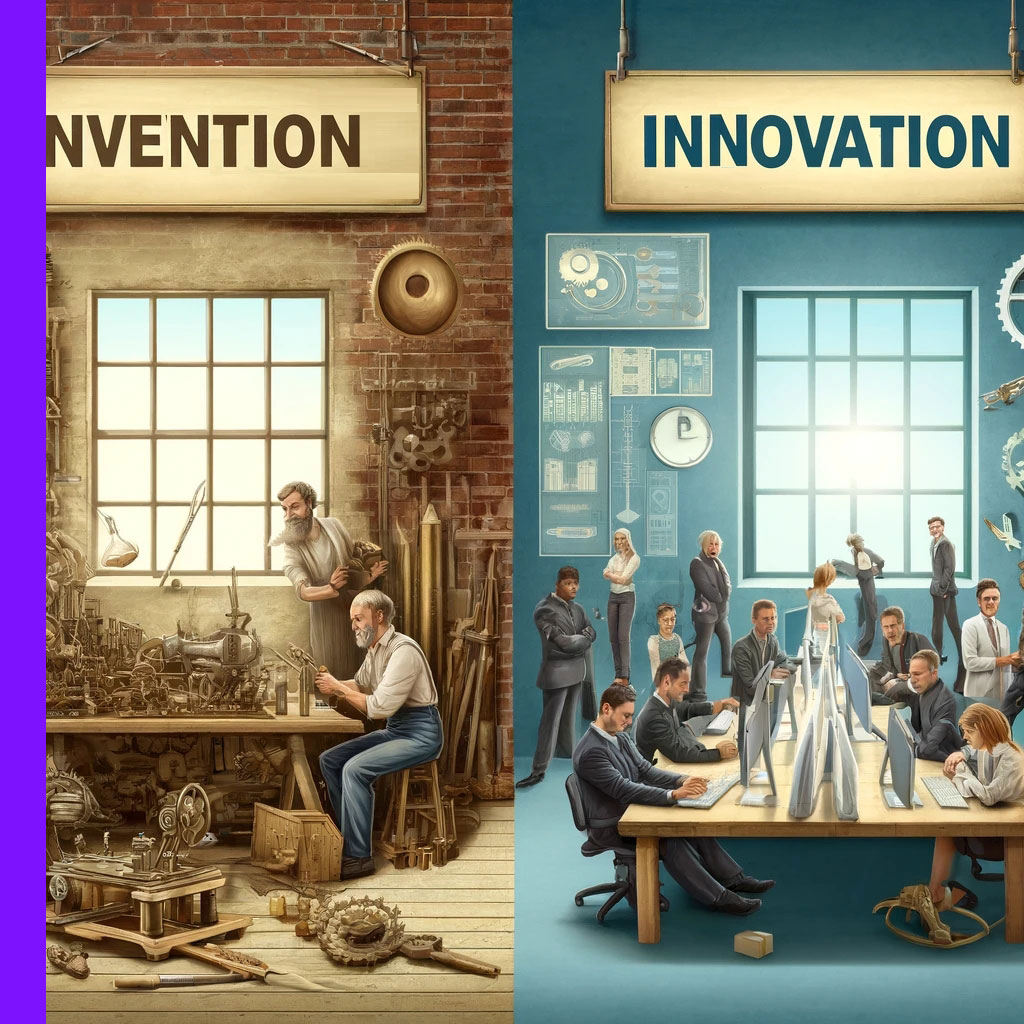
Innovation VS Invention
The distinction between innovation and invention is a fundamental concept in the field of product development and business strategy. Understanding this distinction is not just academic; it has real-world implications for how companies invest their resources, develop products, and create value.
Core Essence
- Invention is the act of creating something completely new and original that did not exist before. It's the birth of an idea or concept that brings forth new possibilities.
- Innovation, on the other hand, involves taking an existing idea, process, or product and improving it or applying it in a new way to create value.
Objective and Focus
- The primary goal of an invention is discovery and creation, often driven by curiosity, research, and the desire to solve a problem or address a need.
- Innovation focuses on application and implementation, aiming to enhance efficiency, effectiveness, or marketability.
Market Impact and Adoption
- Inventions introduce new concepts to the world, but they may not immediately find practical application or market acceptance.
- Innovations are designed with market needs in mind and often lead to widespread adoption, transforming industries and consumer behaviors.
Examples in Technology
- The invention of the lithium-ion battery, initially developed to power handheld electronics, has innovated beyond its original scope to become a cornerstone in powering electric vehicles, renewable energy storage systems, and portable devices, dramatically changing energy consumption and storage across multiple industries.
- The invention of the touchscreen technology, which initially found limited applications, transformed into a widespread innovation as it became integral to smartphones, tablets, and interactive kiosks, reshaping user interaction across devices and industries.
- The invention of cloud computing technology, starting as a way to enable grid computing and on-demand resource allocation, evolved into a major innovation, powering the shift towards remote work, data storage, and computing services, fundamentally changing the IT infrastructure and business operations model.
- The invention of the World Wide Web, initially conceived by Tim Berners-Lee to facilitate information sharing among physicists in universities and institutes around the world, evolved into a global innovation, fundamentally altering how information is accessed, shared, and communicated across the globe, leading to the modern internet era.
- Originally developed formilitary navigation, the invention of GPS technology transitioned into a pivotal innovation for civilian use, enabling precise location and navigation services in smartphones, vehicles, and various applications, revolutionizing travel, logistics, and location-based services.
Cultural and Economic Contributions
- Inventions lay the groundwork for new fields of study and technological domains, contributing to the expansion of human knowledge and capabilities.
- Innovations drive economic growth, create jobs, and often lead to the establishment of new industries and markets.
Challenges and Risks
- Inventors face the challenge of creating something entirely new, which involves significant research, experimentation, and the risk of failure.
- Innovators must navigate market dynamics, competition, and the challenge of scaling an idea to meet consumer demand and achieve commercial success.
In summary, while invention and innovation are interrelated, they occupy distinct roles in the progression from idea to impact. Invention is about creating new possibilities through discovery, whereas innovation is about driving change and creating value by applying and improving upon those discoveries. Together, they fuel the engine of progress, shaping the future of technology, society, and the global economy.
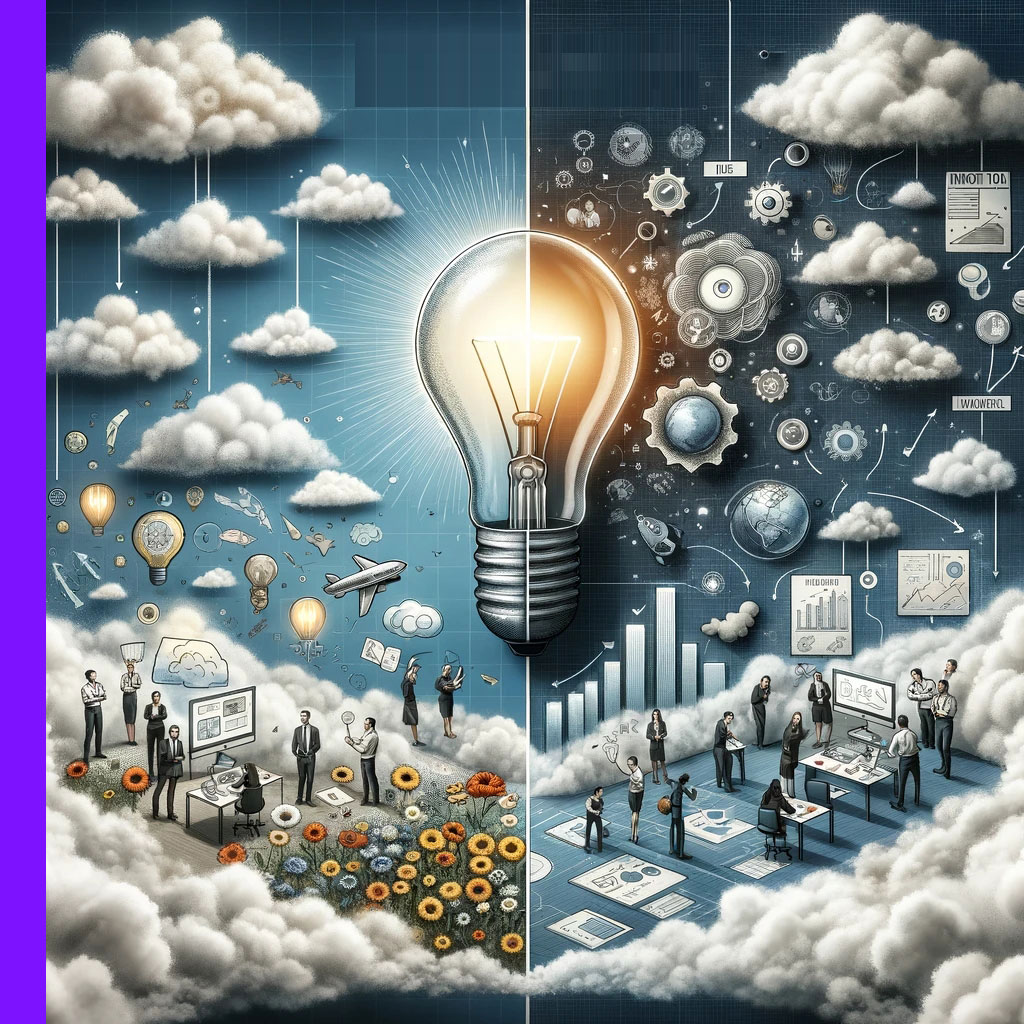
Is Innovation the Same as Idea?
The concepts of innovation and ideas, while interconnected, occupy distinct roles in the process of creating and implementing new products, services, or processes. Understanding their differences is crucial for effective strategy development and execution in any organization.
Ideas as Seeds: Ideas are the seeds from which innovations can grow. They represent the initial spark of imagination or thought that has the potential to solve a problem or address a need. Ideas are abundant and can range from incremental changes to radical breakthroughs.
Innovation as Realization: Innovation is the realization and implementation of an idea. It is the process of transforming an idea into a practical, viable product, service, or method that adds value. Unlike ideas, innovation involves execution, bringing the idea to life in a way that impacts the market or society.
Development Process: An idea requires nurturing, development, and validation before it can become an innovation. This process may involve research, prototyping, testing, and refinement based on feedback and performance.
Market Orientation: Ideas, in their raw form, do not need to demonstrate market viability. However, for an idea to become an innovation, it must prove its worth in the market—meeting customer needs, solving specific problems, or providing new opportunities for growth.
Example
- Having an idea for a new type of energy-efficient light bulb is just the beginning.
- The innovation occurs when that idea is developed, produced, and successfully marketed, changing the way people illuminate their homes and reducing energy consumption.
Challenges and Risks
Not all ideas lead to innovation. The journey from concept to market can be burdened with challenges, including technical feasibility, funding, market acceptance, and competition. Innovation requires overcoming these obstacles.
In conclusion, while an idea is a necessary starting point, it is not synonymous with innovation. Innovation is the process through which ideas are actualized, made tangible, and brought to market, creating real-world impact. Understanding this distinction helps organizations prioritize their efforts and resources towards ideas with the greatest potential for successful innovation.
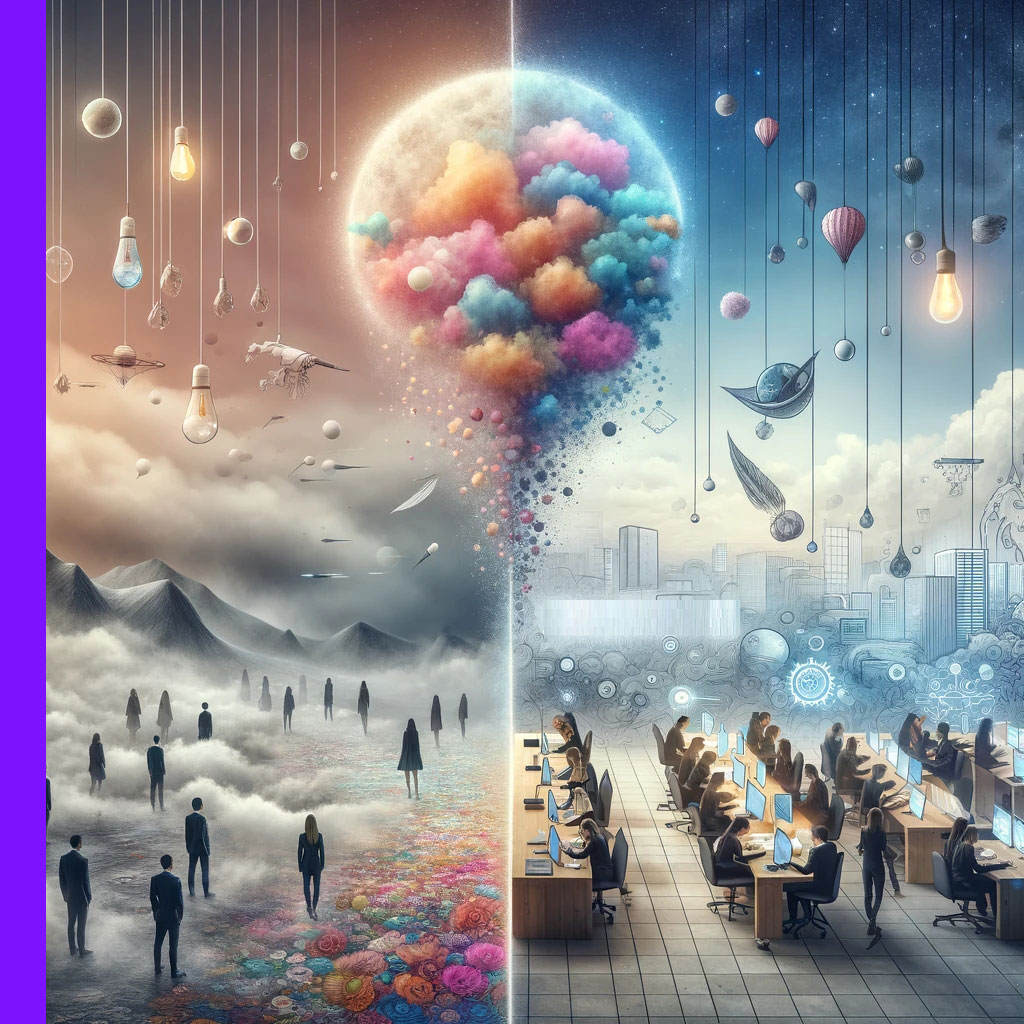
Innovation without Execution is Hallucination
The saying "Innovation without execution is hallucination" encapsulates a profound truth in the business and creative worlds. Having groundbreaking ideas is only part of the journey; the real challenge lies in bringing these ideas to fruition.
Here's why execution is indispensable for innovation:
- Ideas are Plentiful: The world is not short of ideas. Many individuals and companies alike can dream up revolutionary products or services. However, the transition from concept to reality is where many falter. Without execution, ideas remain abstract and untested.
- Execution Brings Validation: Execution transforms ideas from hypotheses into tangible products or services. It's through this process that an idea is validated against the realities of the market, technical feasibility, and consumer preferences.
- Risk and Reward: Execution involves risk. It requires investment, resources, and often, a leap of faith. However, it's also the stage where value is created. An idea, no matter how innovative, cannot generate value unless it's executed and brought to the market.
- Learning Through Doing: Execution is a learning process. It often involves trial and error, adaptation, and problem-solving. Through execution, teams gain insights that can lead to refinements, pivots, or even entirely new ideas that are more aligned with market needs.
- Competitive Advantage: Speed and efficiency in execution can be a significant competitive advantage. In fast-moving sectors, being the first to market with an innovative solution can define a company's success.
- Sustainability: For innovation to contribute to long-term sustainability and growth, it must be executed in a way that meets not only the current but also future market demands and challenges. Execution bridges the gap between short-term success and long-term vision.
Example:
- Consider the tech industry, where many companies have had similar ideas for products or services.
- Often, the winners in this space are those that can execute their ideas most effectively, not necessarily those who had the idea first. This is well demonstrated by the following case study:
 Case Study: Execution at Facebook
Case Study: Execution at FacebookIn the realm of social networking, Facebook's rise to dominance is a testament to the power of execution. While not the first to conceive the idea of a social network, Facebook's journey illustrates how meticulous execution can outpace initial innovation:
- Company: FaceBook, Mentlo Park, California, USA (Founded in 2004)
- Early Landscape: Before Facebook, platforms like MySpace and Friendster were already exploring the concept of online social networks. However, these platforms struggled with issues like user interface complexity and scalability.
- Facebook's Entry: When Mark Zuckerberg launched Facebook in 2004, it was initially just another social networking site among many. However, Facebook differentiated itself not through a novel concept but through superior execution in key areas:
- User Experience: Facebook introduced a cleaner, more intuitive interface that appealed to a broad audience, focusing on ease of use and minimalistic design.
- Scalability and Performance: Early on, Facebook invested in robust backend infrastructure, ensuring that the platform could grow without significant performance hitches, a challenge its predecessors faced.
- Iterative Improvements: Facebook's approach to continuous improvement and feature development, such as the introduction of the News Feed, kept the platform evolving and users engaged.
o Global Expansion: While initially limited to Harvard students, Facebook's strategic expansion to other universities, then high schools, and eventually to the general public, was executed with precision, fueling its rapid growth.
- Monetization Strategy: Facebook's development of an advertising model that leveraged its vast amounts of user data was executed in a way that drove significant revenue while keeping the platform free for users.
The culmination of all these efforts is a platform that not only outlived its early competitors but also became an integral part of daily life for billions of people worldwide. Facebook's success underscores that in the tech industry, while many may arrive at a similar idea, the victor is often the one who executes that idea most effectively. Through relentless focus on execution, Facebook turned a common concept into a global phenomenon, demonstrating that execution truly is everything.
- Company: FaceBook, Mentlo Park, California, USA (Founded in 2004)
In summary, while creativity and idea generation are crucial components of innovation, execution is what turns potential into reality. Without the ability to execute, even the most innovative ideas are doomed to remain as mere fantasies. Therefore, companies and individuals must focus not just on ideation but also on developing the capabilities, processes, and culture that support effective execution.
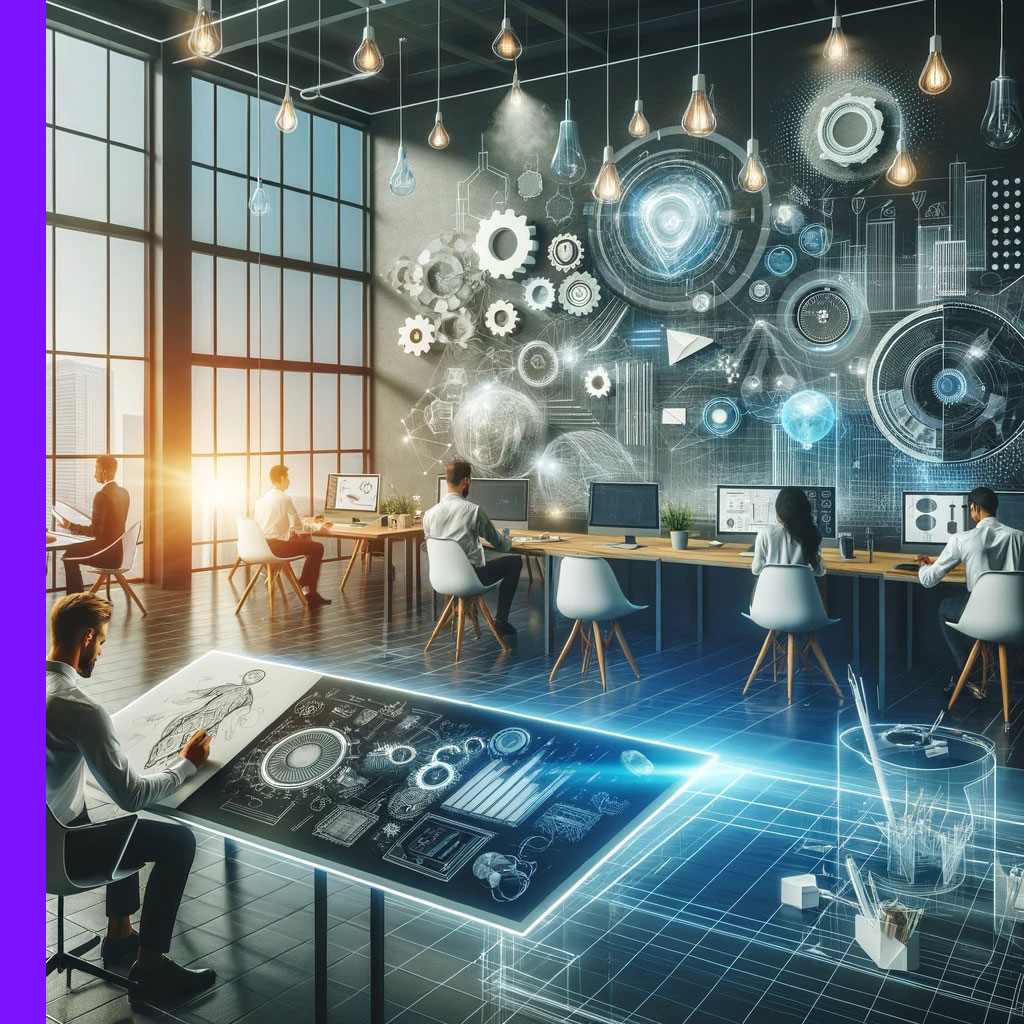
Innovation and Design
The synergy between innovation and design is pivotal in the creation of products, services, and systems that are not only functional but also meaningful and user-centric. This relationship is foundational in addressing complex challenges and delivering solutions that resonate with users.
Collaboration between Innovation and Design
Here's how innovation and design collaborate to push the boundaries of what's possible:
- User-Centric Approach: Design thinking, a core principle in design, places the user at the heart of the development process. It ensures that innovations are not just technologically advanced but also deeply relevant to the people who use them. This approach involves empathy, where designers and innovators immerse themselves in the users' experiences to understand their needs, frustrations, and aspirations.
- Problem-Solving: Both design and innovation are problem-solving activities. Design contributes a methodology for identifying and understanding problems in a human-centered way, while innovation seeks to solve these problems with new and effective solutions. Together, they form a powerful approach to tackling complex issues by focusing on desirability (what users need), feasibility (what is technologically possible), and viability (what is commercially sustainable).
- Prototyping and Testing: A crucial phase where innovation and design intersect is in prototyping and testing. Design brings to innovation the practice of creating rapid prototypes to visualize and test ideas. This iterative process allows teams to experiment, fail fast, learn quickly, and refine their solutions based on real user feedback before finalizing the product or service.
- Aesthetic and Functionality: Design extends beyond functionality to include the aesthetics of a product or service, making it not only useful but also desirable. Good design can differentiate an innovative product in a crowded marketplace, making it stand out to consumers.
- Systems Thinking: Innovations often require changes not just in products but in entire systems. Design thinking provides a framework for understanding and innovating within complex systems, considering all stakeholders and the broader impact of design decisions.
Examples
- The smartphone revolutionized communication by combining innovative technology with intuitive design, making powerful computing accessible to a broad audience.
- Sustainable packaging solutions represent innovation driven by design thinking, addressing environmental concerns while meeting consumer needs.
In conclusion, the convergence of innovation and design is essential for creating solutions that are technologically feasible, commercially viable, and humanly desirable. This partnership is at the core of delivering value that goes beyond mere functionality, encompassing the emotional and experiential aspects that truly connect with users.
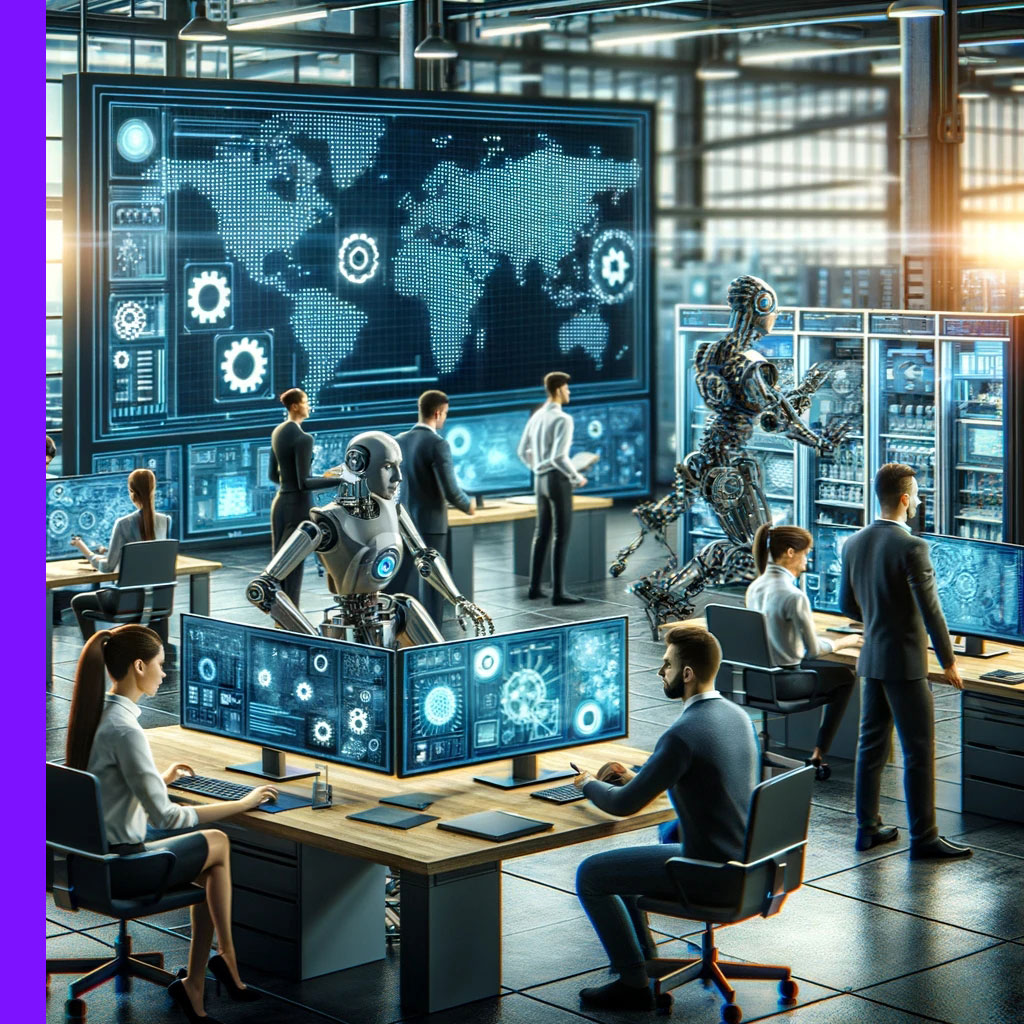
Innovation and Technology
The intertwining of innovation and technology has been a driving force behind the most transformative developments in human history. As we advance, this relationship grows increasingly dynamic, pushing the boundaries of what's possible and reshaping our world.
Collaboration between Innovation and technology
Here's how innovation and technology collaborate to foster progress:
- Enabling New Solutions: Technology acts as the enabler of innovation by providing the tools and platforms necessary to turn creative ideas into reality. Whether it's through advanced computing power, digital connectivity, or new materials, technology offers the means to develop solutions that address complex challenges.
- Accelerating Change: The rapid pace of technological advancement accelerates the rate of innovation. As new technologies emerge, they open up possibilities that were previously unthinkable, leading to new products, services, and ways of doing business. This acceleration is evident in areas like biotechnology, renewable energy, and artificial intelligence.
- Democratizing Innovation: Technology has democratized innovation by making powerful tools available to a broader audience. With access to the internet, cloud computing, and open-source software, individuals and small teams can now pursue innovative projects that would have required significant resources in the past.
- Driving Economic Growth: The fusion of innovation and technology is a key driver of economic growth and competitiveness. It leads to the creation of new industries, job opportunities, and increased productivity. Economies that invest in technological innovation tend to have higher growth rates and can better adapt to changing global conditions.
- Addressing Global Challenges: Together, innovation and technology play a crucial role in addressing global challenges such as climate change, healthcare, and inequality. By leveraging technology, innovators can develop sustainable solutions that have a far-reaching impact, from clean energy systems to digital healthcare platforms.
Case Study: Hackathons Addressing Global Challenges
For tech enthusiasts interested in inventing technologies to address global challenges, participating in hackathons is a fantastic way to contribute. Here are examples of events that focus on using technology to tackle pressing issues:
- The Global Hack: This initiative builds on the "Hack the Crisis" movement, with over 40 hackathons that bring together experts to solve challenges posed by governments, citizens, and organizations. Successful projects from these hackathons receive funding, support to scale, and implement solutions, including online accelerators like Wise Guys and Salto. The Global Hack encourages participation worldwide, offering a platform for collaborative solution development that can have a broader impact than the crises they address.
- SURGE by UNICEF: SURGE is an immersive series of events that aims to engage youth in learning new skills while exploring how blockchain can address global challenges. It includes learning events and hackathons, offering both non-technical and technical participants the chance to engage with blockchain experts and develop solutions under specific themes. Top projects from the SURGE hackathons receive awards, and participants have the opportunity to learn blockchain coding, pitching, design thinking, and more.
- World Engineering Day Hackathon by UNESCO: This annual event, organized in celebration of World Engineering Day for Sustainable Development, invites students worldwide to team up and solve real-world problems. It provides a fast-paced environment where participants can apply their theoretical knowledge, develop critical thinking, and gain hands-on experience in addressing global challenges. Winning teams receive prizes, and the event emphasizes the role of engineering in development and human welfare.
- The Global Hack: This initiative builds on the "Hack the Crisis" movement, with over 40 hackathons that bring together experts to solve challenges posed by governments, citizens, and organizations. Successful projects from these hackathons receive funding, support to scale, and implement solutions, including online accelerators like Wise Guys and Salto. The Global Hack encourages participation worldwide, offering a platform for collaborative solution development that can have a broader impact than the crises they address.
- Fostering a Culture of Continuous Improvement: The integration of technology into products and processes encourages a culture of continuous improvement. Businesses and organizations are constantly seeking ways to use technology to innovate, whether by enhancing existing products or creating entirely new offerings.
Examples
- The technological development of the internet transformed communication, commerce, and information access, spawning countless innovations that have changed every aspect of society.
- Wearable technology, such as fitness trackers and smartwatches, combines innovative design with advanced technology to improve health and wellness.
In conclusion, the symbiotic relationship between innovation and technology is central to driving forward human progress. As technology evolves, it paves the way for new forms of innovation, creating a cycle of advancement that continually reshapes our world. The future will undoubtedly be marked by further integration of innovative ideas with cutting-edge technology, opening new horizons for exploration and growth.
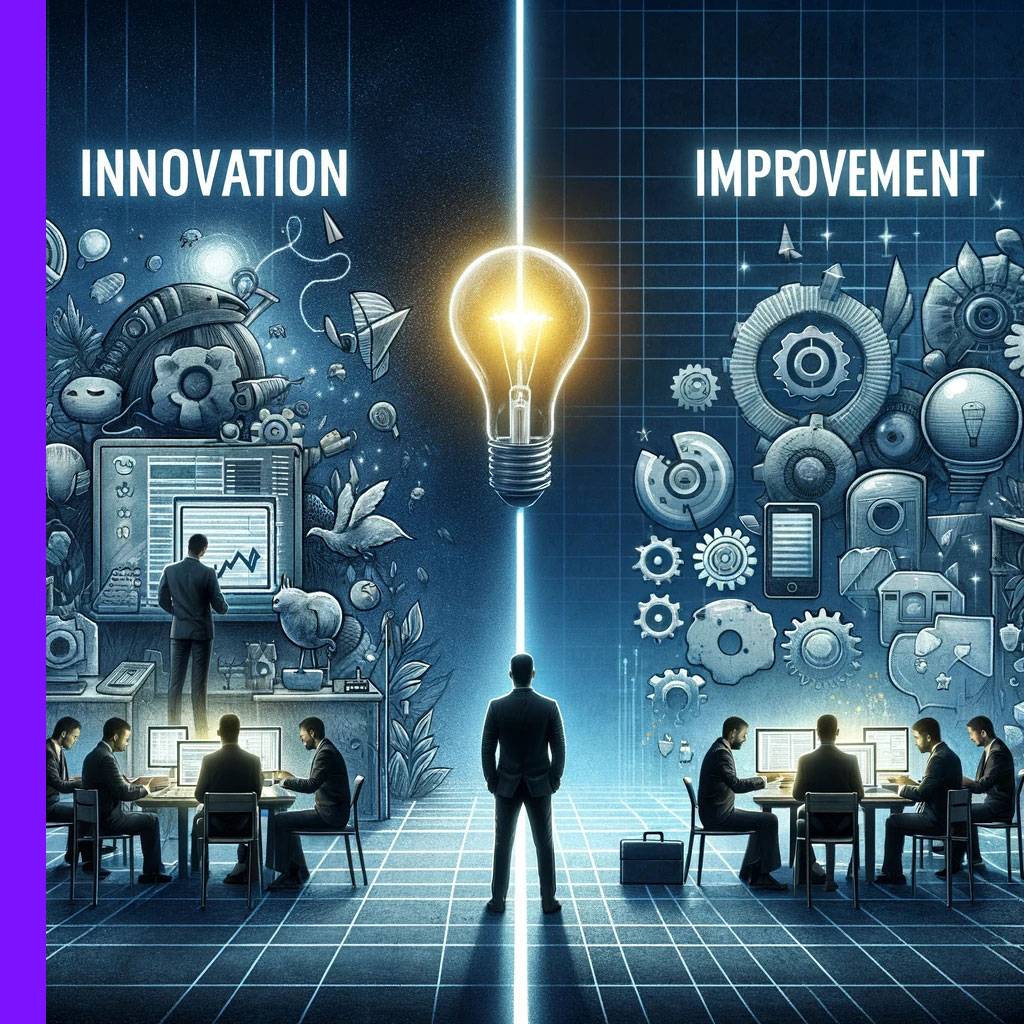
Innovation VS Improvement
In the landscape of change and development, the concepts of innovation and improvement are often discussed. While both are essential for progress, they have distinct characteristics and serve different purposes in the growth of businesses and technologies. Understanding their differences is key to strategically navigating the path to success.
Definition and Focus
- Improvement refers to the process of making something better than it was before. It often involves refining, enhancing, or optimizing existing processes, products, or services. The focus is on incremental change that builds on the current state.
- Innovation, on the other hand, is about introducing something new or doing something in a new way. It can also be radical or disruptive, breaking away from existing paradigms to create new methods, products, or markets.
Scope of Change
- Improvements are typically more contained and incremental. They aim at enhancing efficiency, productivity, or quality within the existing framework.
- Innovations can also be transformative, leading to significant shifts in how needs are met, or problems are solved. They can redefine the framework itself.
Risk and Uncertainty
- Improvement projects generally involve lower risk. Because they build on existing knowledge and resources, the outcomes are more predictable.
- Innovation carries higher risk and uncertainty due to its nature of exploring uncharted territory. The potential rewards, however, can be substantial, offering new competitive advantages or market leadership.
- Example: Government grants that support technological innovation are provided only to projects that tackle uncertain and risky solutions. Counterintuitively, if a technology appears straightforward and easy to manage, the government is often reluctant to sponsor it, as it may not lead to intellectual property development and sustainable innovation.
Impact on Strategy
- Improvement is essential for maintaining quality and competitiveness. It is an ongoing process that supports operational excellence.
- Innovation is crucial for strategic growth and adaptation. It requires a vision for the future and the courage to pursue new directions.
Measurement
- Improvements can often be measured through performance indicators such as time savings, cost reduction, or quality enhancements.
- Innovation's impact might be measured in terms of market share growth, the creation of entirely new markets, or the establishment of new standards.
Examples
- Improvement: Upgrading software to increase processing speed or refining a customer service process to enhance satisfaction.
- Innovation: Developing a new business model like subscription-based services for software (SaaS) or creating a product that opens up a new market, such as the first smartphone.
In conclusion, while both improvement and innovation are vital, they cater to different aspects of development and progress. Improvement optimizes and refines, providing stability and efficiency, whereas innovation disrupts and transforms, fueling growth and opening new opportunities. Successful organizations recognize the importance of both, strategically balancing their efforts to not only sustain their current operations but also to secure their future in an ever-evolving landscape.
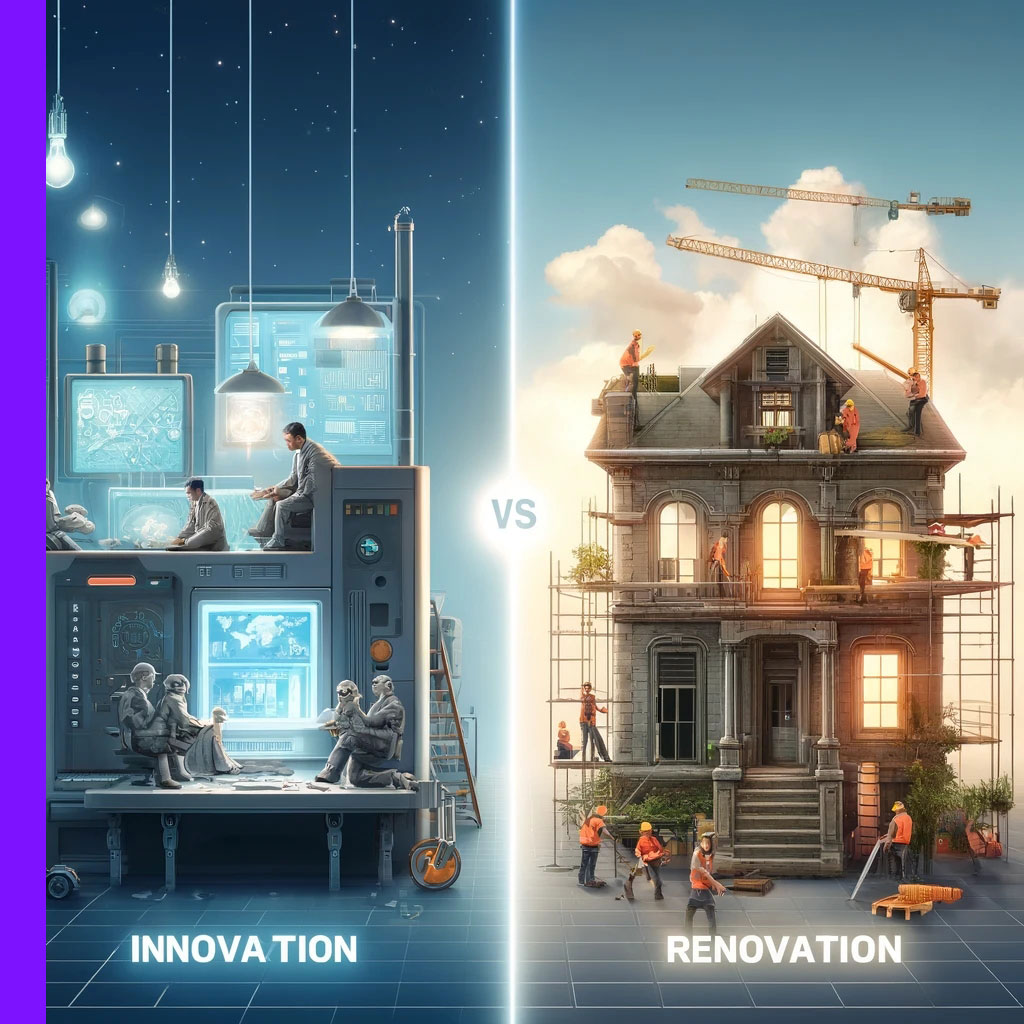
Innovation VS Renovation
In the realms of business, technology, and product development, the terms "innovation" and "renovation" are often discussed in the context of growth and change. Understanding the distinction between these two concepts is crucial for strategic planning and successful implementation.
Definition and Essence
- Innovation involves introducing something new or significantly improving an existing product, service, or process. It's about breakthrough changes that can create new markets or redefine existing ones. Innovation often involves original ideas and approaches that depart from the status quo.
- Renovation, on the other hand, refers to updating, refurbishing, or modernizing something that already exists without fundamentally changing its essence. In a business context, renovation might mean revitalizing a brand, updating product designs, or upgrading technology to meet current standards.
Scope and Impact
- Innovation can be radical or incremental, but it always brings something different to the table, offering new value propositions or creating entirely new markets.
- Renovation improves or refreshes something existing, enhancing its appeal or functionality but not altering its fundamental nature or purpose.
Risk and Investment
- Innovation is often associated with higher risk due to the uncertainties of introducing novel concepts. It requires significant investment in research and development, testing, and market introduction.
- Renovation, while still requiring investment, typically involves less risk since it builds on known entities and markets. The focus is on enhancing and updating rather than creating from scratch.
Objective and Strategy
- The objective of innovation is to achieve growth, capture new markets, or significantly improve efficiency and effectiveness. It's strategic and forward-looking, often requiring a visionary approach.
- Renovation aims to maintain relevance, extend the lifecycle of a product or brand, and improve competitive positioning within existing markets. It's about staying up-to-date and appealing.
Examples
- Innovation: Introducing the first smartphone was an innovation that combined the functions of a phone, computer, and camera into one device, creating a new market.
- Renovation: Refreshing the design of a car model to include the latest technology and more efficient engines is a renovation that improves the existing product.
Outcome
<- Innovations can dramatically alter industries, consumer behaviors, and economic landscapes. They can set new standards and render existing solutions obsolete.
- Renovations can rejuvenate interest in a brand or product, increase market share, and improve customer satisfaction within existing frameworks.
In conclusion, while innovation seeks to introduce the new and unprecedented, renovation focuses on revitalizing and updating what already exists. Both are essential for sustained success in a competitive environment, but they serve different strategic purposes. Understanding when to innovate and when to renovate can be the key to balancing growth and stability.
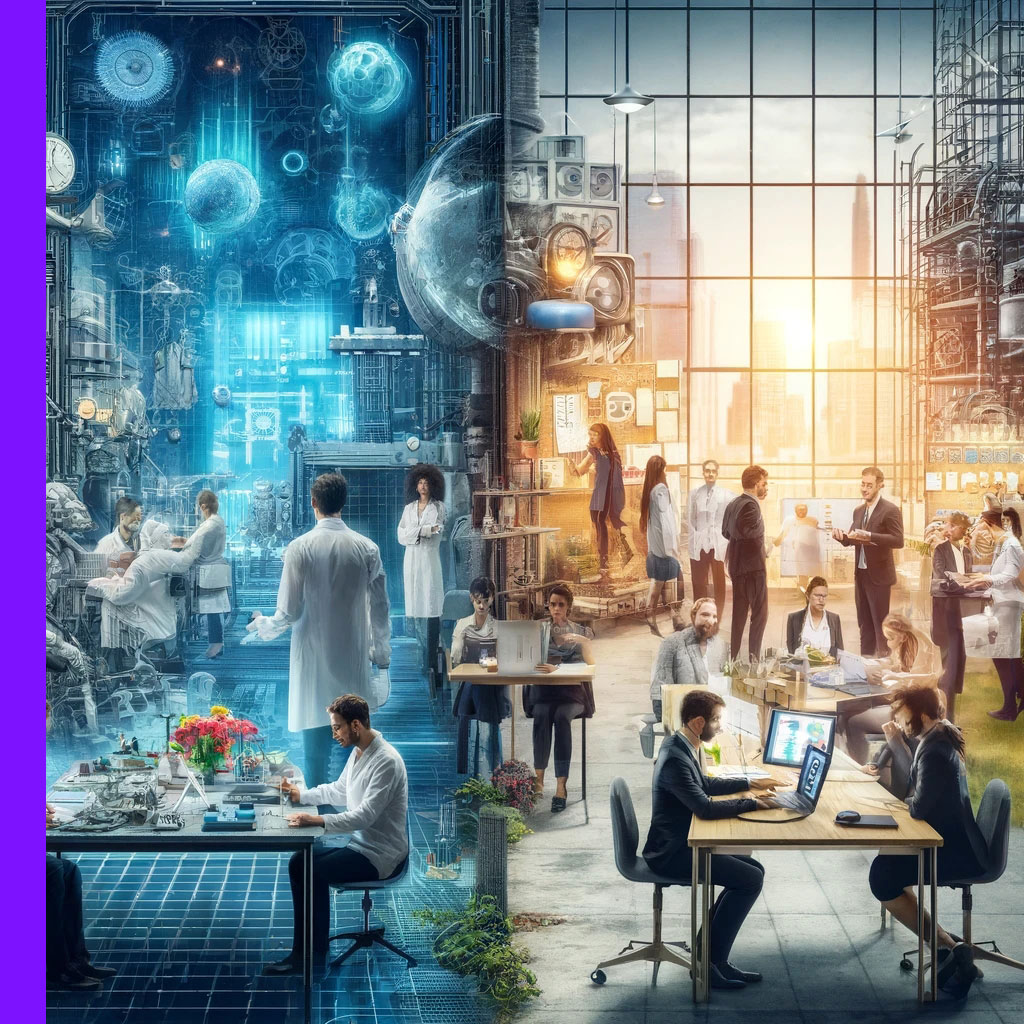
Innovation VS Entrepreneurship
The relationship between innovation and entrepreneurship is often discussed in the context of driving economic growth and advancing social progress. While closely linked, these two concepts have distinct characteristics and play different roles in the business ecosystem.
Definition and Core Essence
- Innovation involves creating new products, processes, or ideas, or significantly improving existing ones. It's about introducing something novel that adds value, whether through incremental changes or disruptive breakthroughs.
- Entrepreneurship is the act of launching and managing a new business venture to capitalize on market opportunities. Entrepreneurs identify needs, mobilize resources, take risks, and drive the commercialization of innovations.
Function and Focus
- Innovation is primarily concerned with the creation and development of new ideas, improving technologies, or refining services. It's the engine for new solutions that meet unaddressed needs or enhance efficiency.
- Entrepreneurship focuses on turning those innovative ideas into viable business models. It's about execution, market entry, and scaling operations to achieve sustainable growth.
Risk and Challenges
- Innovators face the challenge of creating something valuable and potentially disrupting the status quo. The risk lies in the uncertainty of acceptance and practical applicability of the innovation.
- Entrepreneurs take on the financial and operational risks associated with establishing and growing a new enterprise. They navigate market dynamics, competition, and the challenges of building a customer base.
Impact and Outcome
- Innovations can lead to significant societal and economic impacts by introducing efficiencies, enabling new capabilities, or improving living standards. The success of an innovation is measured by its adoption and the value it adds.
- Entrepreneurship drives economic growth by creating jobs, fostering competition, and stimulating further innovation. Successful entrepreneurship is measured by business growth, profitability, and longevity.
Examples
- Innovation: Developing a new renewable energy technology that significantly reduces the cost of solar power.
- Entrepreneurship: Starting a company that manufactures and sells solar panels based on the new technology, creating a new market segment.
 Case Study: SolarEdge
Case Study: SolarEdge- Company: SolarEdge, Herzliya, Israel (Established in 2006)
- What Was Done: SolarEdge exemplifies the transition from innovation to entrepreneurship within the renewable energy sector. Starting as a tech startup, the company focused on enhancing the efficiency and lowering the cost of energy from photovoltaic systems through its intelligent inverter and battery solutions. Their technology, which includes power optimizers for each solar panel, has been instrumental in optimizing power generation.
- Results/Impact: Rapid growth and market leadership were achieved through high-volume, high-quality manufacturing, leading to the installation of millions of units globally. This case demonstrates the critical role of execution in turning a technological innovation into a successful business that addresses global energy challenges. Read more about it here.
Synergy
- While distinct, innovation and entrepreneurship are synergistic.
- Innovation provides the foundation for new entrepreneurial ventures.
- Entrepreneurship is the mechanism through which innovations reach the market and society at large.
In conclusion, innovation and entrepreneurship are two sides of the same coin, each indispensable to the other. Innovation fuels the creation of new products and services, while entrepreneurship transforms these innovations into economic and societal gains. Together, they form a dynamic force that drives progress, competitiveness, and development.

Innovation and Strategy
Innovation and strategy are intertwined concepts critical for the sustained success and growth of organizations. A strategic approach to innovation ensures that companies not only generate new ideas but also align these ideas with their overall business goals and market needs.
Here's how innovation integrates with strategy to create competitive advantages and drive long-term success:
- Strategic Alignment - Purposeful Innovation: Innovation must be purposeful, aligned with the strategic goals of the organization. It’s not about innovating for the sake of innovation but about solving the right problems that will move the company forward.
- Market Orientation - Understanding Market Needs: Strategic innovation is rooted in a deep understanding of current and future market needs. It involves identifying gaps in the market or anticipating shifts in consumer behavior to develop solutions that meet these needs effectively.
- Resource Allocation - Investing Wisely: Strategic innovation requires careful allocation of resources. Companies must decide where to invest their time, talent, and capital to maximize the impact of their innovation efforts. This includes deciding which projects to pursue, scale, or abandon.
- Risk Management - Balancing Risk and Reward: Strategic innovation involves balancing the inherent risks of innovation with potential rewards. It means taking calculated risks and being prepared to pivot or adapt based on feedback and market response.
- Competitive Advantage - Differentiation and Positioning: Innovation, when executed strategically, can provide a significant competitive advantage. It can differentiate a company’s offerings, create new value propositions, and position the company as a leader in its field.
 Case Study: Vovlo and Car Safety
Case Study: Vovlo and Car Safety- Company: Volvo, Sweden (Established 1927)
- What Was Done: Volvo's legacy in car safety is marked by significant innovations: the three-point seatbelt in 1959, revolutionizing passenger safety; the introduction of the Side Impact Protection System (SIPS) in 1991, enhancing protection against side collisions; and the launch of the Blind Spot Information System (BLIS) in 2003, improving driver awareness.
- Results/Impact: These milestones, among others, underline Volvo's enduring commitment to safety, setting industry benchmarks and saving lives worldwide.
- Culture and Leadership - Fostering an Innovative Culture: Strategy and leadership play crucial roles in fostering a culture that values and encourages innovation. This includes creating an environment where experimentation is encouraged, failure is seen as a learning opportunity, and creative thinking is rewarded.
- Example: Apple’s success with products like the iPhone and iPad demonstrates how strategic innovation can redefine markets. By understanding consumer needs and leveraging technology in novel ways, Apple created new product categories and established itself as a market leader.
- Sustainability and Growth: Strategic innovation is about ensuring the long-term sustainability and growth of the organization. It’s about continuously scanning the horizon for opportunities and threats and being agile enough to respond.
In conclusion, innovation and strategy are not separate endeavors but are deeply connected. A strategic approach to innovation ensures that efforts are aligned with the broader goals of the organization, effectively addressing market needs, and positioning the company for long-term success. In today’s rapidly changing business environment, integrating innovation into the strategic planning process is not just advantageous—it’s essential.
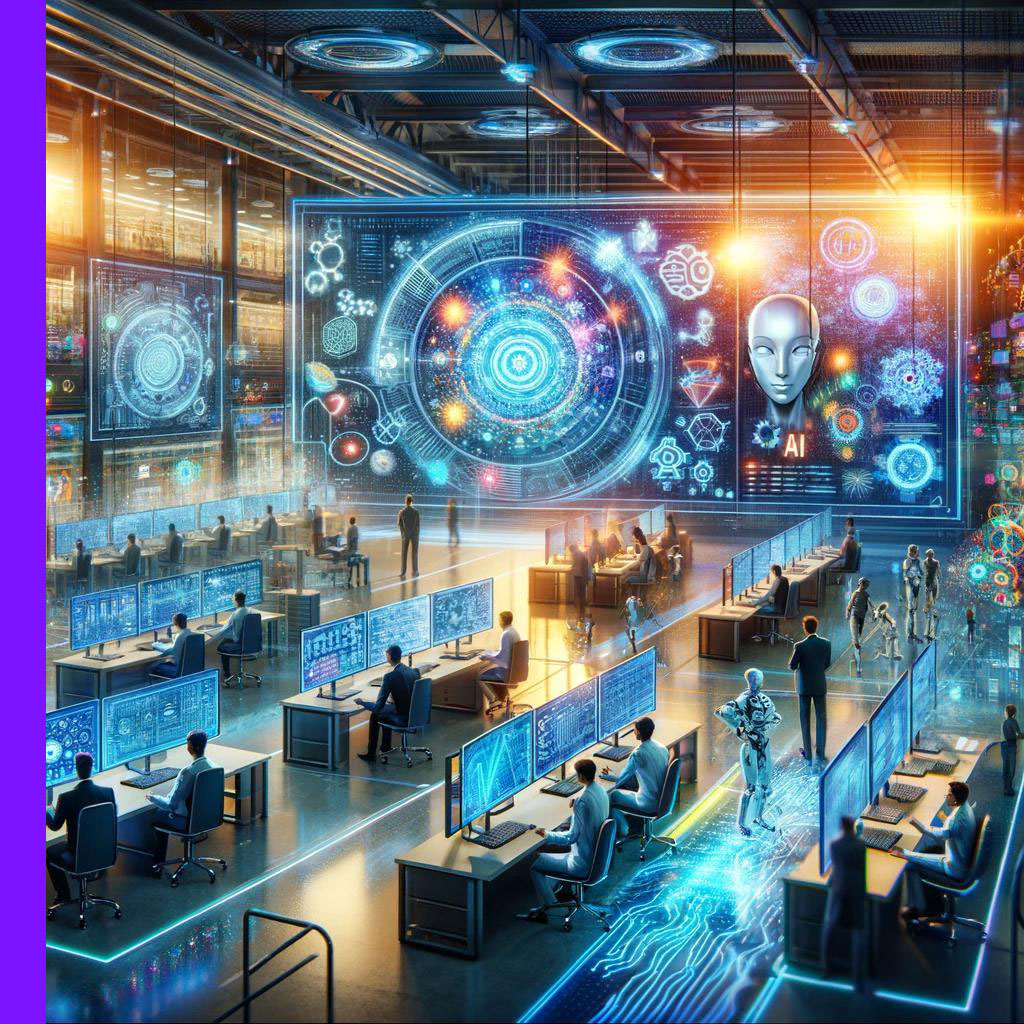
Innovation with AI
The integration of Artificial Intelligence (AI) into the innovation process represents a paradigm shift in how organizations approach problem-solving, product development, and service enhancement. AI's capabilities in data processing, pattern recognition, and predictive analytics have opened new frontiers for innovation, making it possible to explore solutions that were previously unimaginable.
Following we elaborate on how AI is revolutionizing the landscape of innovation.
Accelerating Discovery
- AI algorithms can analyze vast datasets far more quickly than humans, identifying trends, correlations, and insights that can lead to new innovations. This capability accelerates the discovery phase of innovation, enabling faster ideation and conceptualization.
- Examples: AI and Drug Discovery
- Pfizer's used IBM Watson to accelerate cancer drug research, identifying potential new treatments faster than traditional methods.
- Atomwise applied AI to predict successful drug candidates, notably identifying a potential treatment for Ebola.
- Benevolent.AI used its AI platform to uncover a previously unknown ALS treatment pathway, leading to the development of new therapeutic strategies.
- Examples: AI and Drug Discovery
Enhancing Creativity
- AI tools, such as generative design software, can produce multiple design alternatives based on specified criteria, pushing the boundaries of human creativity. This not only speeds up the design process but also introduces novel concepts that may not have been considered.
- Autodesk's use of generative design AI in the architectural and engineering sectors allows professionals to input design goals and constraints, generating numerous innovative design alternatives. This not only accelerates the design process but also uncovers solutions that might not have been initially considered by human designers.
Predictive Innovation
- Through predictive analytics, AI can forecast future trends and consumer behaviors, guiding organizations in developing products and services that meet anticipated needs. This forward-looking approach ensures that innovations are not just reactive but proactive.
- Netflix's recommendation engine exemplifies predictive innovation by analyzing vast amounts of data on viewing preferences to forecast future trends and suggest personalized content. This not only enhances user experience but also guides Netflix in developing original content that aligns with anticipated viewer interests.
Personalization at Scale
- AI enables the personalization of products and services at an unprecedented scale. By understanding individual user preferences and behaviors, companies can innovate personalized experiences that significantly enhance customer satisfaction and loyalty.
- Spotify's Discover Weekly feature uses AI to analyze listening habits and curate personalized playlists for each of its millions of users. This level of personalization at scale significantly improves user satisfaction and engagement, showcasing AI's ability to tailor experiences to individual preferences.
Optimizing Operations
- AI-driven innovations streamline operations, reduce costs, and improve efficiency. For example, predictive maintenance systems use AI to foresee equipment failures before they occur, minimizing downtime and operational disruptions.
- General Electric employs AI in its Predix platform for predictive maintenance, analyzing data from industrial equipment to predict failures before they happen. This reduces downtime and saves costs by preemptively addressing maintenance issues, optimizing operational efficiency across its manufacturing processes.
Facilitating Collaborative Innovation
- AI tools can enhance collaborative innovation by connecting distributed teams, managing complex projects, and facilitating the exchange of ideas. This collaborative environment, supported by AI, can accelerate the development of innovative solutions.
- Microsoft's GitHub Copilot, powered by AI, assists programmers by suggesting lines of code or entire functions as they type, facilitating collaborative software development. This AI tool helps developers to work more efficiently and innovate by allowing them to focus on more complex and creative tasks.
Ethical and Sustainable Innovation
- AI offers opportunities for ethical and sustainable innovations, from optimizing resource use to developing solutions for social and environmental challenges. However, it also requires careful consideration of ethical implications, ensuring that AI-driven innovations contribute positively to society.
- Examples for AI impact:
- Google's AI for Social Good program leverages AI to address societal and environmental challenges, such as predicting natural disasters, protecting wildlife, and improving access to clean water. This initiative demonstrates AI's potential to drive sustainable innovation while emphasizing the importance of ethical considerations in AI development.
- One notable example of AI's ethical implications is the deployment of facial recognition technology. While it offers benefits for security and identification purposes, it raises significant privacy, consent, and bias concerns. For instance, studies have shown that some facial recognition systems exhibit racial and gender biases, leading to higher error rates in identifying individuals from certain demographic groups. This not only perpetuates discrimination but also raises questions about the fairness and transparency of AI systems. The use of facial recognition by law enforcement and in public spaces without explicit consent further complicates the ethical landscape, prompting debates on the balance between security and individual privacy rights.
- Examples for AI impact:
How AI Impacts Innovation in Various Industries
- Finance: AI-driven algorithms for fraud detection and risk assessment are enhancing security and personalizing financial advice, fundamentally changing how consumers and institutions manage finances.
- Retail: From personalized shopping recommendations to inventory management, AI is reshaping the retail experience, making it more customized and efficient.
- Manufacturing: AI in manufacturing optimizes production lines, improves quality control with predictive maintenance, and streamlines supply chain management, significantly increasing efficiency and reducing costs.
- Agriculture: AI technologies are being used to predict crop yields, optimize planting schedules, and monitor soil health, leading to increased efficiency and sustainability in farming practices.
- Transportation: In the transportation industry, AI powers autonomous vehicles, optimizes routing for logistics and public transport, and improves safety features, revolutionizing how goods and people move.
- Education: AI personalizes learning experiences through adaptive learning platforms, provides automated grading, and enhances student engagement, offering tailored educational pathways.
- Energy: AI improves energy efficiency through smart grid management, predicts energy demand, and optimizes the distribution of renewable energy resources, contributing to sustainability efforts.
- Entertainment: In the entertainment sector, AI curates personalized content, enhances user interfaces, and drives the creation of realistic computer-generated imagery (CGI), transforming how content is produced and consumed.
- Healthcare: AI innovations in healthcare, such as diagnostic algorithms and personalized treatment plans, are transforming patient care, making it more accurate, personalized, and accessible.
- Customer Service: AI chatbots and virtual assistants have revolutionized customer service, offering personalized, 24/7 support and enhancing customer experiences.
In conclusion, AI is not just a tool for innovation but a transformative force that redefines what is possible. By leveraging AI, organizations can unlock new levels of creativity, efficiency, and personalization, driving forward the next wave of innovations that will shape the future. As AI continues to evolve, its integration into the innovation process will undoubtedly lead to breakthroughs that will redefine industries and improve our world in profound ways.
Systematic innovation
Interested in getting help with systematic innovation processes and developing new products and services?
Contact us: [email protected] ,+972-9-958-5085
Innovation Articles
- Innovation - overview
- Innovation management and process
- Innovation tools and methods
- Innovation and other disciplines
- Innovation in organizations
- Innovation importance and goals
- Innovation values and inspiration
- Innovation education and career
- Product and service innovation
- Technological innovation
- Innovation examples
- Innovations across various industries
- Innovation terms (glossary)





